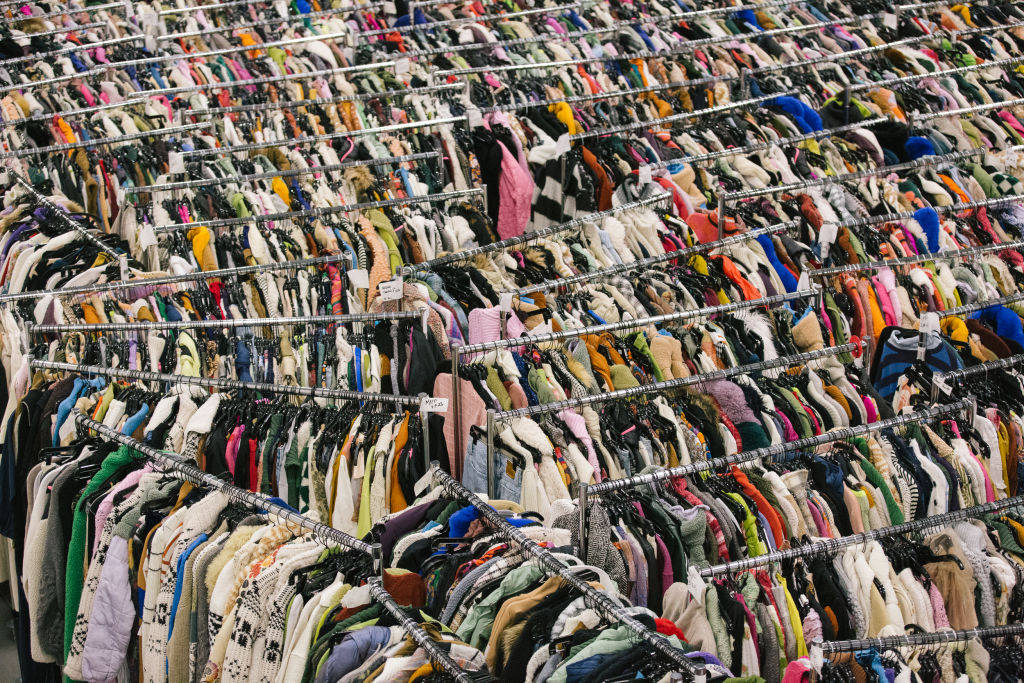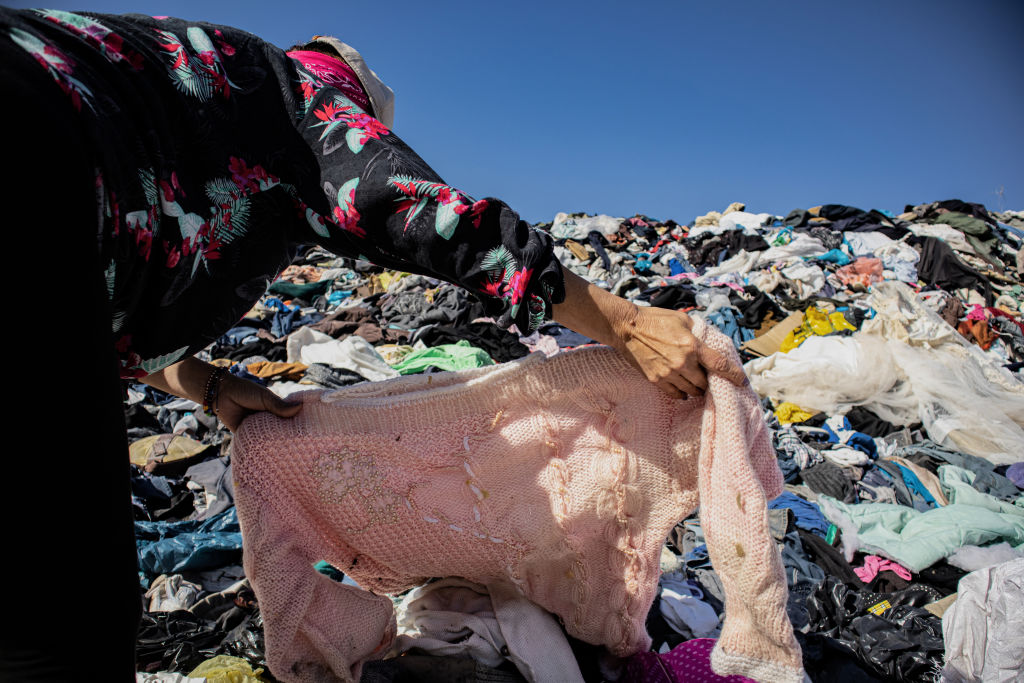
This month, three shirts, two dresses, and a pair of shorts arrived at my door. They’re mine, but only for a month. After that, I’ll pack them in a reusable tote bag and send them to a warehouse in Pennsylvania, where they’ll be cleaned and shipped to their next (temporary) owner.
Along with more than 150,000 other people—most of them, like me, women between the ages of 25 and 35—I subscribe to Nuuly, a rental service operated by URBN, the parent company of brands including Anthropologie, Free People, and Urban Outfitters. For just shy of $100 a month, I get a regular influx of new clothing—and a chance to clear my conscience.
Depending on which estimate you read, the fashion industry is responsible for anywhere from 4% to 10% of global greenhouse-gas emissions. The process of growing, harvesting, and processing raw materials; making those materials into textiles that become clothing; and transporting garments to stores around the world is incredibly water-, chemical-, and energy-intensive. And after all that, most clothing sold in the U.S. turns into waste, worn fewer than 50 times before ending up either incinerated or in a landfill.
More from TIME
Services like Nuuly, which launched in 2019, aim to disrupt at least the latter part of that cycle by keeping clothes in circulation longer. In addition to its core business of renting clothes, Nuuly repairs garments that have seen better days—more than 250,000 in 2022—operates a resale platform called Nuuly Thrift, and upcycles some old clothes into new garments. The combined result, says Nuuly president Dave Hayne, is that clothes live “the longest life possible.”
Increasingly, other fashion labels are adopting similar “circular” initiatives, so named because they keep materials in repeated use. Brands from Lululemon to Vince, Express to J.Crew, H&M to Juicy Couture have in recent years launched their own resale, rental, or recycling services, joining multi-brand resale and rental giants like Poshmark, the RealReal, and Rent the Runway. These business models aren’t new in concept—just look to thrift shops and tuxedo rentals for proof—but they are being embraced by traditional fashion labels with a new intensity, often branded as ways to help customers not only look good, but also do good for the planet.
The business imperative is clear. Circular fashion could grow into a $700 billion industry by 2030, according to one estimate from the Ellen MacArthur Foundation (EMF), a nonprofit that promotes a circular economy. Survey after survey suggests that shoppers care about sustainability and consider a product’s environmental impact when deciding what to buy. So it behooves clothing brands to clean up their acts—or at least their narratives.
But there’s bad news for consumers who, like me, have turned to these business models in hopes of becoming more ethical shoppers. At least right now, the PR benefits of these campaigns seem to outpace their environmental benefits. Even EMF concluded in a 2021 report that, although they hold great promise and may make a bigger impact in the future, programs like clothing rental, recycling, and resale do not always benefit the environment in their current forms.
“If we want to create a thriving, nature-positive fashion industry, then we need a radical transformation of the way products are designed and made,” says Jules Lennon, who runs EMF’s fashion-related projects. Right now, she says, most circular programs are small add-ons for fashion labels, rather than substantive efforts to change an industry with consumption and waste built into its foundations.
“If you leave a bath running and it starts to overflow, you could grab some towels and try and mop up the water, but that doesn’t solve the problem,” Lennon says. “The only real solution is to turn off the tap.”

A 2021 paper published in Environmental Research Letters painted a fairly bleak picture of circular fashion. It compared a baseline shopping scenario—buying a pair of jeans, wearing them for a while, and eventually tossing them—with alternative options like renting, reselling, or recycling the jeans.
The paper found that reselling was better than baseline—but cautioned that the benefits would be limited if buyers were choosing secondhand clothes in addition to, not instead of, new outfits. Recycling was only modestly better, mostly because recycling is itself energy intensive. And rental, the authors found, was actually worse for the environment than the standard scenario, largely because of the transportation involved in sending shared pants back and forth.
Jarkko Levänen, co-author of the study, says it’s not “completely fair” to use his research to argue against any specific companies, since their practices might differ from those laid out in the paper’s theoretical models. It’s the larger point of the research, he says, that’s more important: “not all activities or business models that are built on principles of sharing economy or circular economy are automatically sustainable.”
Indeed, there are drawbacks to all of the alternative retail models currently in use, even if there are also good aspects. Rental keeps clothes in use longer, which is particularly beneficial for items, like formalwear, that are usually worn only a handful of times. But it can also be hard on the environment, largely because many rental platforms operate by shipping clothes back and forth. Plus, whereas the average person probably doesn’t wash their jeans or jacket after every use, shared garments are typically cleaned after each rental. Traditional laundry is a drain on water and energy, while chemicals used in dry cleaning can be hazardous to both people and the planet.
Textile-recycling programs sound similarly promising: old clothes become new clothes. But in reality, only around 1% of recycled clothes are actually remade into apparel, research suggests. Most are either burned, sent to landfill, or “downcycled” into materials of lower utility, like insulation.
That’s largely because current recycling methods aren’t able to process different materials at the same time, says Denise Green, an associate professor of fiber science and apparel design at Cornell University. When consumers drop off bags of old clothes for recycling, they need to be sorted by type of fabric. That’s a daunting task, especially since many modern garments are blends of multiple materials. “Can you find denim pants that don’t have a little bit of spandex or elastane that has been spun into the fiber?” Green asks. “That makes it really challenging to recycle the cotton from denim.” (There’s a growing movement to make clothes from materials that are easier to recycle or eco-friendlier in the first place—dye produced from food waste is one exciting area, Green says—but there’s a long way to go before they’re adopted at scale.)
Read more: Depop Made Sustainable Shopping Cool for Gen Z. What Happens When Parents Crash the Party?
Resale is perhaps the most straightforward option for brands interested in circularity. There’s little downside to selling a preowned shirt instead of a new one, right? Maybe so—but most brands aren’t selling secondhand merchandise instead of new goods, but rather in addition to them. That’s where things get messy.
Most fashion houses’ bread and butter is still making and selling new clothes, year after year and season after season. Globally, billions upon billions of new garments are churned out each year. Even as resale and rental businesses grow, they’re barely making a dent in that staggering amount of new production, says Ken Pucker, a lecturer at the Fletcher School at Tufts University and former chief operating officer at Timberland.
“At the same time that claims of ‘sustainability’ and ‘green’ and ‘eco’ and ‘organic’ have gone up exponentially, so too has the environmental damage associated with the industry,” Pucker says.
The big problem, Lennon says, is that most brands are trying to fit sustainability initiatives into their existing businesses, rather than making changes from the ground up. For example, companies often incentivize customers to bring in old clothes for resale or recycling by offering discounts on new purchases, which keeps them beholden to a business model that relies on newness.
Things aren’t so different in rental. Hayne says Nuuly’s goal isn’t to drive down production of new clothes across URBN’s brands, but rather to be a “growth engine” for the parent company. Nuuly earned URBN $130 million in revenue last year, and subscriber numbers increased almost 150% from the end of fiscal year 2021 to 2022.
Nuuly customers do, however, tend to report that they buy less new clothing overall after joining the platform, says Nuuly’s executive director of marketing, Kim Gallagher. And Nuuly is committed to keeping its clothes in circulation for a long time. The platform is actively renting 19,000 of the garments it launched with in 2019, in large part thanks to its repair program.
Many mass-market brands, by contrast, churn out garments that are either low-quality, and thus fall apart, or that are so trendy that they quickly look outdated, sending customers back to the store for the latest thing. This style of production also limits the potential of rental and resale, Lennon notes, because flimsier garments aren’t built to last through multiple cycles of ownership.
A “combination of physical durability, emotional durability, and designing to be remade and recycled is really critical to develop circular business models,” Lennon says. By and large, that’s not happening across the industry.

Some brands, however, are trying. One is outdoor-gear maker Patagonia, which has long offered repairs on worn-out or damaged garments, usually for free, to discourage customers from buying anything new. It’s done the same with its marketing. In one infamous ad, a photo of a Patagonia fleece was accompanied by the words, “Don’t buy this jacket.” Patagonia executives also made headlines in 2021 for publicly swearing off the word “sustainable,” acknowledging that—as a company that continues to make new stuff—it is part of the problem.
There’s probably some reverse psychology at play here: by owning its shortcomings, Patagonia boosts its reputation and becomes a brand people want to support. Aileen Ottenweller, the company’s head of brand and business impact, acknowledges that buzzy campaigns do sometimes lead to spikes in sales—but she also maintains there’s a genuine recognition within Patagonia that “everything we make has a footprint [and] we are in an environment where we cannot sustain the amount of things being made.” Patagonia is committed to making resale a larger part of its overall business over time, she says.
Reformation, a trendy clothing brand known for its vintage and upcycled clothing, is heading in a similar direction, says Kathleen Talbot, the company’s chief sustainability officer. As of 2022, resale, vintage, and rental made up 16% of Reformation’s total business volume and the brand has committed to growing those channels in proportion with its overall business. It has also pledged to make all of its clothes recyclable by 2030 and phase out almost all virgin materials.
“If we, in the industry, are equating a resale program with sustainability [without going further] that’s frankly a mistake,” Talbot says. “It’s really missing some of these bigger systemic challenges and opportunities.”
Read more: Why the Staff of LVMH, Europe’s Most Valuable Company Is Getting ‘Climate Training’
Circularity initiatives like rental, resale, and recycling are better than nothing, even if they’re not perfect. At the very least, they make people think about how unsustainable fashion has been up to this point and highlight other ways of doing business, says Cornell’s Green. But there’s still a long way to go.
As Pucker sees it, real progress requires policy solutions like the Fashion Act, which would require major brands doing business in New York to map their supply chains, look for places to minimize environmental damage therein, and adhere to science-backed sustainability targets, with the threat of significant fines for those that don’t comply. (The bill was first introduced to the New York State Senate during the 2021-2022 legislative session, but faced some opposition; it was reintroduced earlier this year but has not yet gone up for a vote.) The Federal Trade Commission is also overhauling its standards for how brands can use sustainability claims in their marketing.
In the meantime, consumers are often left to make their best guesses about how an item they’re buying, renting, or thrifting actually affects the environment—an overwhelming and unfair proposition for shoppers, Pucker says, since the onus should be on brands to do things differently.
But there is another choice, says Levänen, who co-authored the 2021 study on sustainability of circular fashion. Shoppers could simply stop shopping. “The best option is not to buy or sell anything but to use what you have in your closet,” he says.
It’s not a pitch fashion labels are likely to find appealing. But it’s the truth that’s been there all along, and one we can no longer afford to ignore.
More Must-Reads From TIME
- The 100 Most Influential People of 2024
- How Far Trump Would Go
- Scenes From Pro-Palestinian Encampments Across U.S. Universities
- Saving Seconds Is Better Than Hours
- Why Your Breakfast Should Start with a Vegetable
- 6 Compliments That Land Every Time
- Welcome to the Golden Age of Ryan Gosling
- Want Weekly Recs on What to Watch, Read, and More? Sign Up for Worth Your Time
Write to Jamie Ducharme at jamie.ducharme@time.com